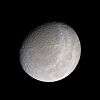Phobos monolith


The Phobos monolith is a large rock on the surface of Mars's moon Phobos.[1] It is a boulder about 85 m (279 ft) across.[2] A monolith is a geological feature consisting of a single massive piece of rock. Monoliths also occur naturally on Earth, but it has been suggested that the Phobos monolith may be a piece of impact ejecta. The monolith is a bright object near Stickney crater, described as a "building sized" boulder, which casts a prominent shadow.[3][4] It was discovered by Efrain Palermo, who did extensive surveys of Martian probe imagery, and later confirmed by Lan Fleming, an imaging sub-contractor at NASA Johnson Space Center.
The general vicinity of the monolith is a proposed landing site for a Canadian Space Agency vehicle, funded by Optech and the Mars Institute, for an unmanned mission to Phobos known as PRIME (Phobos Reconnaissance and International Mars Exploration).[3] The PRIME mission would be composed of an orbiter and lander, and each would carry four instruments designed to study various aspects of Phobos' geology.[5] At present, PRIME has not been funded and does not have a projected launch date.
The object appears in Mars Global Surveyor images SPS252603 and SPS255103, dated 1998. The object is unrelated to another monolith located on the surface of Mars, which NASA noted as an example of a common surface feature in that region.[6]
See also
References
- ↑ Science Illustrated - The Mysterious Moons Of Mars (10.24.2011)
- ↑ PIA04746: Boulders on Phobos
- 1 2 Optech press release, "Canadian Mission Concept to Mysterious Mars moon Phobos to Feature Unique Rock-Dock Maneuver," 3 May 2007.
- ↑ PRIME: Phobos Reconnaissance & International Mars Exploration, Mars Institute website, accessed 27 July 2009.
- ↑ Mullen, Leslie (30 April 2009). "New Missions Target Mars Moon Phobos". Astrobiology Magazine. Space.com. Retrieved 5 September 2009.
- ↑ A rectangular object found jutting out of Mars's surface and caught on camera by the University of Arizona has caused speculation over the nature of the "monolith" and its origins. 9:45AM BST, 6 August 2009
External links
| Wikimedia Commons has media related to Phobos. |
- USGS Mars Global Surveyor MOC Image 55103 - Browse Page Monolith Zoom
- Analysis in year 2000 by of Lan Fleming of SPS252603 and SPS255103
- Phobos in general
